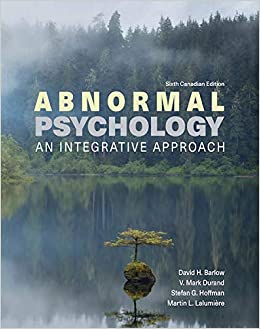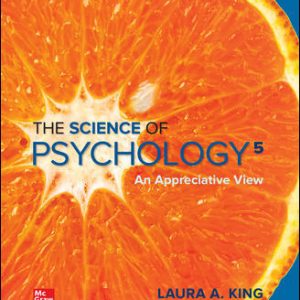No products in the cart.
Psychology
 Loading...
Loading...
Abnormal Psychology An Integrative Approach, 6th canadian Edition David H. Barlow, V. Mark Durand, Stefan G. Hofmann, Martin L. Lalumière 2020 Test Bank
Abnormal Psychology An Integrative Approach, 6th canadian Edition David H. Barlow, V. Mark Durand, Stefan G. Hofmann, Martin L. Lalumière 2020 Test Bank
Abnormal Psychology
( Test Bank)
Abnormal Psychology An Integrative Approach, 6th canadian Edition David H. Barlow, V. Mark Durand, Stefan G. Hofmann, Martin L. Lalumière 2020 Test Bank
Edition: 6th canadian Edition
Author Name:David H. Barlow, V. Mark Durand, Stefan G. Hofmann, Martin L. Lalumière
contact:
Whatsapp +1 (949) 734-4773
for the Facebook page click here
for more books for ( Test Bank and Solution Manual) click here
sample free
 Loading...
Loading...
$49.00 $100.00
Abnormal Psychology An Integrative Approach, 6th canadian Edition David H. Barlow, V. Mark Durand, Stefan G. Hofmann, Martin L. Lalumière 2020 Test Bank
Abnormal Psychology
( Test Bank)
Abnormal Psychology An Integrative Approach, 6th canadian Edition David H. Barlow, V. Mark Durand, Stefan G. Hofmann, Martin L. Lalumière 2020 Test Bank
Edition: 6th canadian Edition
Author Name:David H. Barlow, V. Mark Durand, Stefan G. Hofmann, Martin L. Lalumière
contact:
Whatsapp +1 (949) 734-4773
for the Facebook page click here
for more books for ( Test Bank and Solution Manual) click here
sample free
| Indicate the answer choice that best completes the statement or answers the question. |
1. Why was electroconvulsive therapy originally used as a therapy for schizophrenia?
|
2. According to Abraham Maslow’s hierarchy of needs, individuals will be unable to achieve high levels of self-actualization and self-esteem unless which of the following has taken place?
|
3. How do most mental health professionals view psychoanalysis as a treatment technique?
|
4. After receiving the results of four different sets of tests, Mary’s doctor tells her that she has cancer. Mary states, “This can’t be true; I’m going to get a second opinion.” Which defence mechanism does this example illustrate?
|
5. What is the name for learning in which a neutral stimulus is paired with a response until it elicits that response?
|
6. Statistical data are relevant to researchers. For example, one major epidemiological study found that about 7.8 percent of people in North America have had a mood disorder at some point in their lives and 3.7 percent have experienced a mood disorder over the past year. What do the 7.8 percent and 3.7 percent statistics refer to, respectively?
|
7. When 20-year-old Larry was first identified as suffering from schizophrenia, his family wanted to know how the disorder would progress and how it would affect him in the future. In medical terms, what did the family want to know?
|
8. Ron has just been diagnosed with schizophrenia and hospitalized. What would Thomas Szasz most likely argue?
|
9. According to psychoanalytic theory, what function does a person develop early in life to ensure that they can adapt to the demands of the real world while still finding ways of meeting their basic needs?
|
10. A four-year-old girl sucks her thumb, a teenager binges on food, and an adult woman bites her fingernails. According to the Freudian theory of psychosexual development, what underlies all these behaviours?
|
11. In the Middle Ages, one of the chief advisers to France’s King Charles V, Nicholas Oresme, suggested that which of the following was responsible for bizarre behaviour?
|
12. Bloodletting, often through the use of leeches, was a treatment devised centuries ago. What was this treatment used for?
|
13. Who is the concept of a “hierarchy of needs” most strongly associated with?
|
14. You are listening to old musical tunes, including “Melancholy Baby.” Your friends are impressed when you tell them that “melancholic,” referring to a depressive personality, derives from the Greek term melancholer. What does this term mean?
|
15. In most Western societies, what happens when a person enters a trance state and believes he or she is possessed?
|
16. Which Greek philosopher suggested that maladaptive behaviour was rooted in social and cultural factors?
|
17. Which of the following is a characteristic of how defence mechanisms affect coping styles?
|
18. Who was the first theorist to argue that genetics were related to abnormal functioning?
|
19. What is the relationship between a presenting problem and a clinical description?
|
20. Why are operant conditioning techniques being applied in Canadian hospital settings?
|
21. Realizing patients are often unaware of material previously recalled under hypnosis, Breuer and Freud hypothesized the existence of a concept considered one of the most important developments in the history of psychopathology. What was that concept?
|
22. According to psychoanalytic theory, what do the conflicts between the id and the superego often lead to?
|
23. During more superstitious times, which of the following was thought to be the cause of abnormal behaviour?
|
24. The ego operates according to one principle, and the id operates according to another principle. What are they, respectively?
|
25. What is the formal definition of psychopathology?
|
26. Jack and Kelly have been dating for six months. Kelly is not interested in continuing their relationship. She calls Jack and informs him that although she cares about him, she must end their relationship. Jack laughs and says, “Funny joke.” Kelly states, “This is not a joke; I am serious.” Jack then says, “I’ll pick you up in an hour for dinner.” Which defence mechanism does this example illustrate?
|
27. Jason has been having a lot of difficulty because of his irrational fears. His doctor advises Jason to participate in an anxiety-reduction procedure based on the work of Joseph Wolpe. What is this procedure?
|
Based on 0 reviews
0.0 overall
0
0
0
0
0
Be the first to review “Abnormal Psychology An Integrative Approach, 6th canadian Edition David H. Barlow, V. Mark Durand, Stefan G. Hofmann, Martin L. Lalumière 2020 Test Bank” Cancel reply
Related products
-
Psychology
The Science of Psychology: An Appreciative View 5th Edition Laura King © 2020 Test Bank and Solution Manual
PsychologyThe Science of Psychology: An Appreciative View 5th Edition Laura King © 2020 Test Bank and Solution Manual
Rated 5.00 out of 5(2)Test Bank + Solution manual
Book Name: The Science of Psychology: An Appreciative View
Edition :5th 2020
Author name:Laura King
contact:
[email protected]
SKU: n/a -
Psychology
Wrightsman’s Psychology and the Legal System 9th Edition Edie Greene , Kirk Heilbrun , © 2019 , Test Bank and Instructor Solution Manual
PsychologyWrightsman’s Psychology and the Legal System 9th Edition Edie Greene , Kirk Heilbrun , © 2019 , Test Bank and Instructor Solution Manual
Rated 5.00 out of 5(2)Test Bank and Solution Manual
Book Name: Wrightsman’s Psychology and the Legal System
Edition :9thEdition
Author name: Kirk Heilbrun , © 2019
contact:
[email protected]
SKU: n/a







There are no reviews yet.